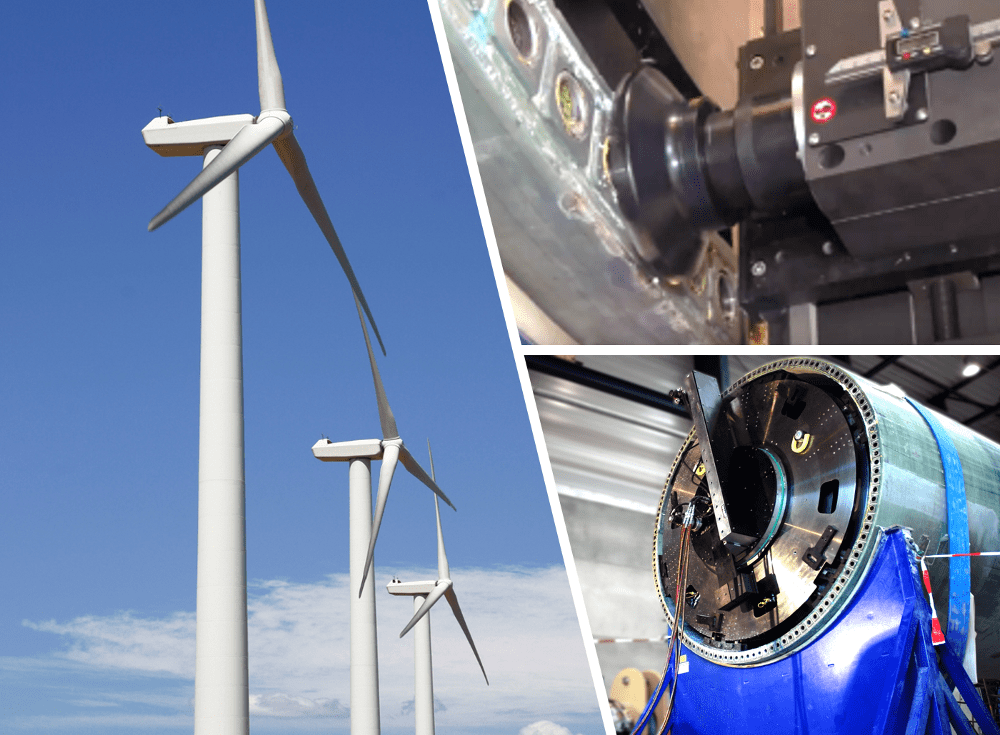Tools for Wind Turbine Assembly and Maintenance
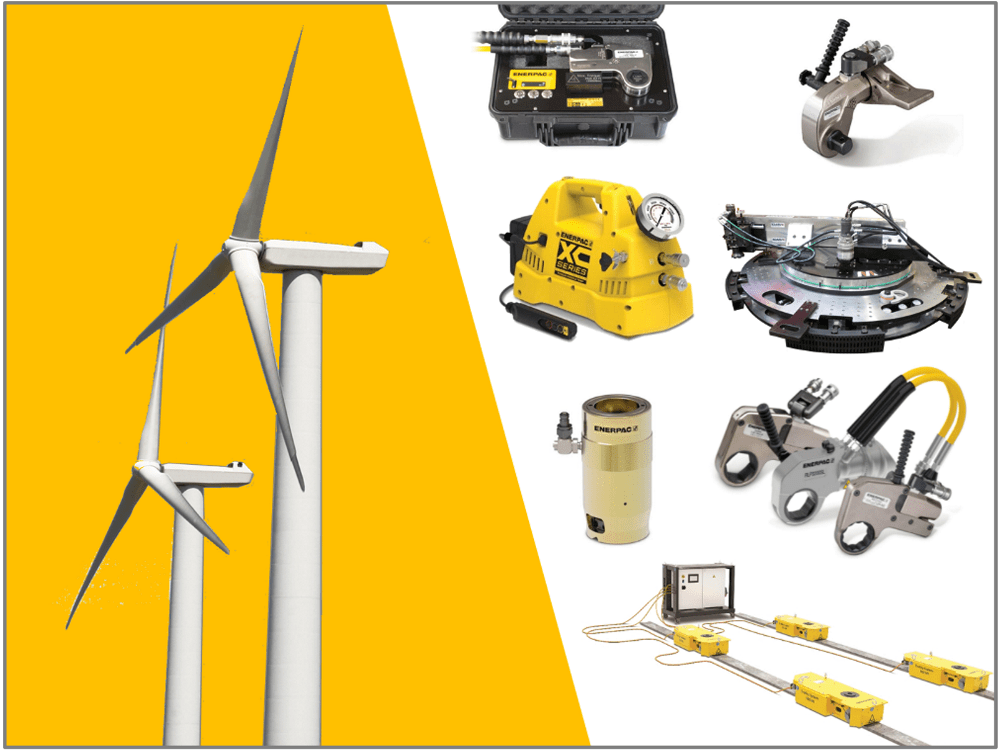
May 11, 2021
0
There are many different types of tools for wind turbine applications used for manufacture, assembly, and maintenance.
The drive towards more carbon-free power generation means that wind turbine manufacturers, installers, and maintenance crews will face an increasing workload and a growing need for industrial tools and equipment.
Let’s take a look at some tried and tested products used for applications in the wind power industry.
MACHINING TOOLS
Application: Turbine Blade Root End Machining
Machine: WP Orbital Milling Machine
Ever wondered how turbine blades are manufactured? Or how they’re secured or attached to the central hub?
Wind turbine blades are fabricated from fiberglass using a mold, similar to the way many yachts and boats are made. The ‘root end’ of the blade is a composite of fiberglass embedded with metal blocks, each containing a female thread. The root end is a critical part of the blade, as this is where it is bolted onto the rotating hub.
For the turbine to operate smoothly and be balanced, it is essential that each of the blade root end is machined perfectly flat. With the blades being so long, any inaccuracy at the root end could have a huge impact on the balance of the turbine.
How Turbine Blade Root Ends are Machined
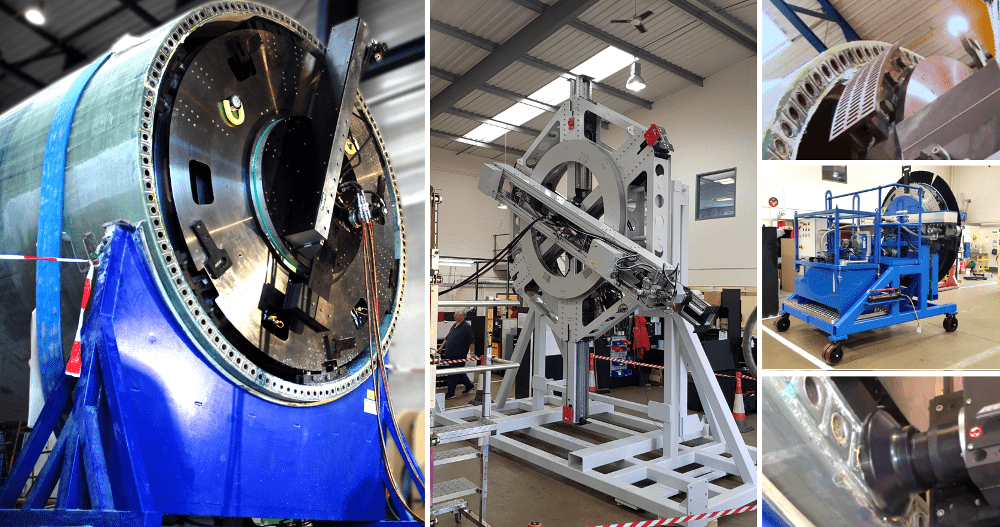
Ensuring turbine blade root ends are flat is achieved during manufacturing using a ‘WP’ (Wind Power) orbital milling machine. The machine is offered to the root end of each blade from a purpose-designed trolley.
Next, the machine clamps into the inside diameter of each blade using a hydraulic mechanism built into the machine base.
The trolley is then detached to allow the machine’s hydraulically powered milling head to work its way around the blade diameter. Typical flatness accuracy of +/- 0.15mm across the whole diameter is achieved.
When machining is complete, the trolley is re-attached to the machine, the hydraulic clamping device is deactivated, and the machine can now move onto the next blade.
Application: Wind Turbine Tower Machining
Machine: OM Orbital Milling Machine

Wind turbine towers are manufactured in sections and connection flanges on each of these need to be flat. Common practice is to machine the connection flanges positioned at the bottom of the tower, and also the generator flange at top of the tower. These are machined in the vertical orientation using an ‘OM’ orbital milling machine, similar to the WP machine mentioned above.
HEAVY LIFTING EQUIPMENT
Application: Moving Offshore Wind Tower Transition Pieces
Equipment: ETR Electric Trolley System

Offshore wind turbine towers are more complex than those used on land.
The tower foundation is made from two different sections; A ‘monopile’ is the lower section anchored to the seabed, which rises just above sea level. Attached to the top of this is a ‘transition piece’, which as the name suggests, links the monopile to the wind turbine tower.
A typical transition piece is approximately 5 meters (16.4 ft) diameter and has a wall thickness between 40 to 80mm. Weighing several hundred tons, these require specialist equipment to move them from the dockside to within reach of an onboard crane.
An example describing how an Electric Trolley System was used to move 500-ton transition pieces can be found on the Enerpac website here. What made the ETR ideal for this application is the smooth action supplied by four trolleys that traveled along a 90-meter track. Also, an integrated hydraulic clamping and leveling system with a wireless control unit enabled a fully integrated and synchronized operation.
Application: Installing Offshore Wind Turbine Base Foundations
Equipment: Synch Hoist System

Turbine base foundations need to be installed as close to vertical as possible. If they aren’t, it will be difficult to ensure the transition piece and turbine tower are vertical as well.
This can be done using a below-the-hook sync hoist system integrated into a crane.
A case study on the Enerpac website describes how four sync hoist units were attached to an x-frame. This arrangement allowed high-precision and wireless maneuvering of the foundation. Four cylinders were used to balance, tilt, and position the load in response to feedback from four leveling sensors on the foundation.
More Heavy Lifting Equipment Options for Moving Sub-Assemblies

The movement of large and heavy wind turbine components may require different or additional types of moving equipment than those described above. This may be during manufacture, or when offloading for transportation to the wind farm. Types of heavy lifting equipment available include:
Hydraulic Gantries, Skidding Systems, Self-Propelled Transporters, Strand Jacks, Turntables, and Jack-Up Systems.
TORQUE AND TENSIONING PRODUCTS
Applications: Wind Turbine Tower Assembly and Maintenance
Tools for wind turbine applications: Hydraulic Torque Wrenches, Bolt Tensioners, Flange Alignment Tools, Hydraulic Pumps, Safe TM Torque Checker, Nut Splitters
Wind turbine blades are rarely stationary, which means constant vibration can potentially loosen tower fasteners, or any bolted joints securing machinery within the nacelle.
That’s why installers and maintenance teams go to great lengths to ensure each bolt is secure and correctly tensioned. Fortunately, there are many types of torque and tension products available to do this effectively.
Hydraulic Torque Wrenches
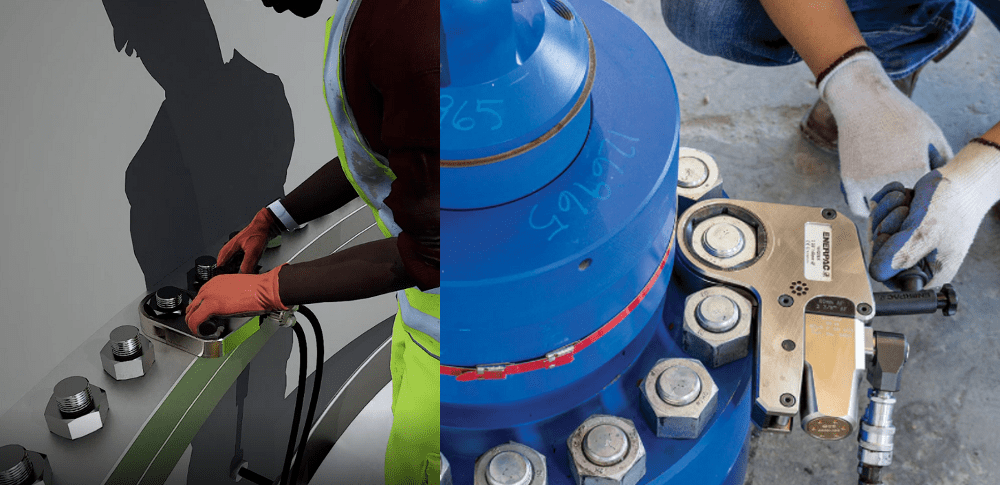
Hydraulic torque wrenches are available in ‘square-drive’ types – which work with separate hex sockets, or the ‘low-profile’ type to which hexagonal cassettes are attached.
The low-profile types are ideal for low clearance applications, for example, when bolts are positioned very close to each other. Many also include tether features for safer working at height – a must-have requirement when working on wind towers.
The buyers’ guide on the Enerpac website is a useful resource that gives an overview of the different types of torque wrench.
Hydraulic torque wrenches can be used to bolt the tower sections together. Other applications for them include assembly and maintenance work inside the ‘nacelle’. (The nacelle is the section at the top of the tower that contains the gearbox, low- and high-speed shafts, generator, controller, and brake).
Bolt Tensioners

Torque wrenches and bolt tensioners work to accomplish the same objective, which is to clamp nuts and bolts together to secure a joint. Bolt tensioners work by directly stretching the bolt against the flange, (rather than nut rotation from the torque wrench). Tensioning typically creates a more accurate load required on larger bolts.
Benefits of Bolt Tensioners include:
- Speed – quick to install and operate.
- Simultaneous– multiple tools can be actuated at the same time and achieve the same load in each bolt.
- Safer – no pinch points or difficulties in finding a reaction point. Tensioners are hands-free during pressurization.
- Accuracy – very high accuracy (5% or better).
- No need to lubricate studs – tensioning is not affected by friction.
Bolt tensioners are available in designs created specifically for the power generation industry and provide an effective solution for tightening foundation bolts.
They include performance-enhancing features; such as auto-retract pistons, cycle counters, and premium coatings for enhanced durability.
Wind Tower Flange Alignment Tools
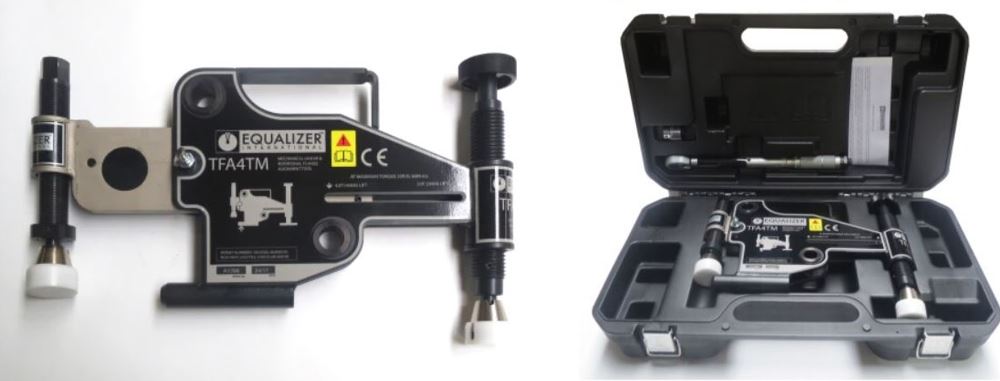
Bolting operations can only be completed if the bolt holes are correctly aligned. When misalignment occurs during a tower construction project, a simple portable flange alignment tool can be used to bring the holes closer together.
Hydraulic Pumps
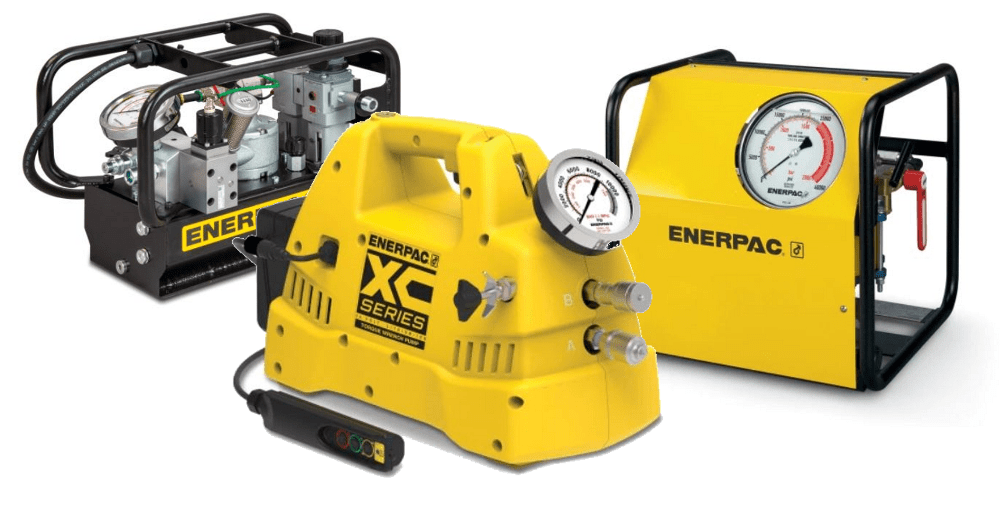
Whichever method you use, both hydraulic torque wrenches and bolt tensioners need a hydraulic pump to drive the tools. When working on a wind tower, portability is important and battery-powered models fulfill this need by being easy to transport and suited to tight spaces. Pumps for hydraulic torque wrenches and tensioners are available in cordless, electric, and air-powered models.
Safe T Torque Checker
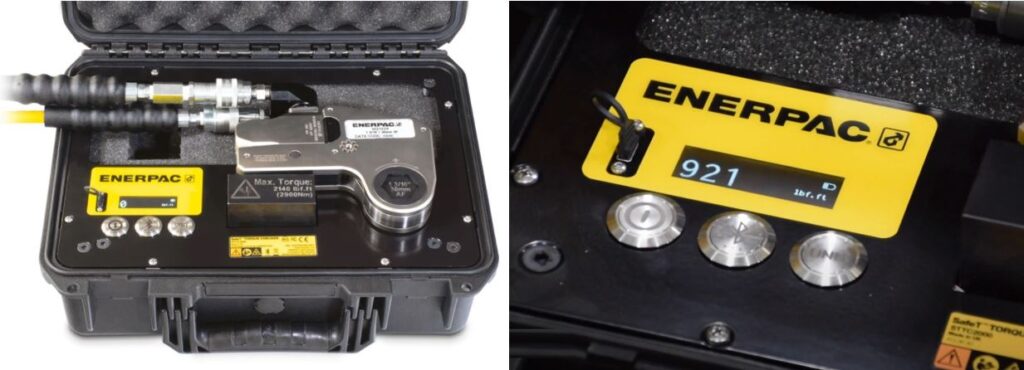
How can you be sure your hydraulic torque wrench will deliver the required torque?
A simple way to find out is with the Safe T Torque Checker. Your torque wrench may have been calibrated recently in isolation within a workshop environment, but this clever tool verifies the torque of the full hydraulic system on the jobsite – the torque wrench with the pump and hose attached. The digital readout displays the torque to within +/- 1% , so this is a more accurate way to confirm the torque that will be delivered on the actual job.
Nut Splitters
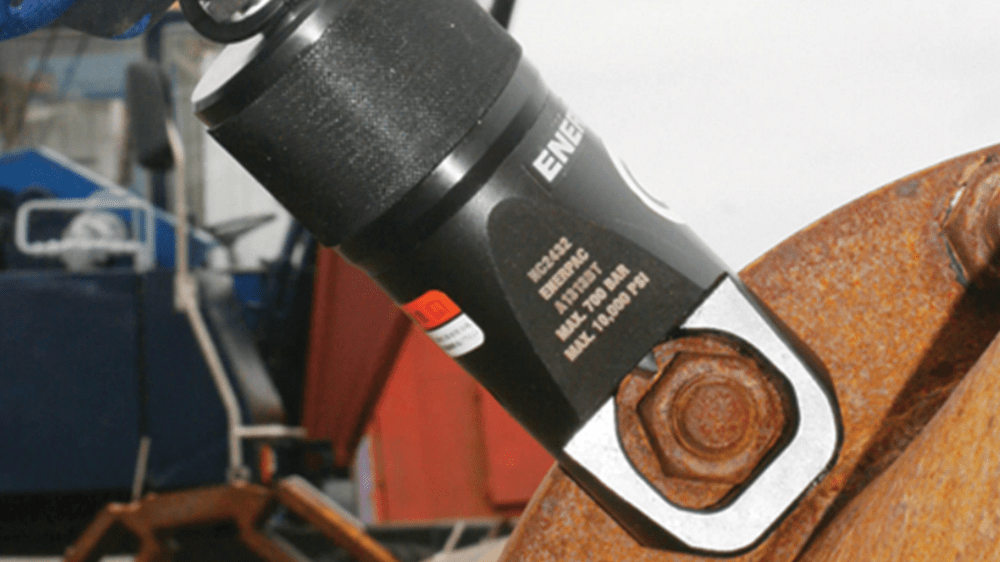
During maintenance, if a stubborn nut needs to be loosened and it won’t budge, there is the option to remove it with a nut splitter. Compared to other methods, using a hydraulic nut splitter is a safer method. It takes less time and avoids costly damage to other components nearby.
Need help selecting the right tools? Connect with an Enerpac Power Generation Specialist.


